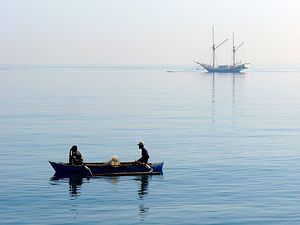Earlier this week Australia and Timor-Leste reached an agreement for a treaty on their disputed maritime border at the Permanent Court of Arbitration in The Hague. The agreement will establish a maritime boundary between the two countries in the Timor Sea for the first time. The conciliation proceedings also decided on the revenue sharing arrangement for the Greater Sunrise offshore gas fields.
The established practice for determining maritime boundaries was codified in 1982 by the United Nations Convention on the Laws of the Sea (UNCLOS). The median line between the two states would delineate each state’s Exclusive Economic Zone (EEZ). Prior to this, maritime boundaries had been negotiated bilaterally. The complicated nature of Timor-Leste’s history, and the maritime boundaries established prior to it gaining sovereignty, led to the recent dispute.
In 1972 Indonesia and Australia negotiated the Australia–Indonesia Maritime Delimitation Treaty. This was a complex bilateral agreement that assigned separate sovereignty over the seabed and waters above it (known as the “water column”). Australia’s sovereignty extends to the end of the continental shelf, giving it rights over minerals within the seabed past the median line. However, Indonesia’s rights to the water column extend to the median line between the two countries. This effectively gave Australia rights to the seabed resources over the median line, with Indonesia obtaining fishing rights up to the median line.
However Portugal, at the time still the sovereign power over the eastern section of the island of Timor, did not agree to this boundary assessment. This left a gap as to where the international boundary between Australia and the then-Portuguese Timor lay. Portugal believed that boundary should be based on the median line between Australia and its territory on Timor, as became the international convention. When Portugal decolonized the island in 1975 the boundary remained in dispute.
After Indonesia annexed Timor-Leste upon Portugal’s departure, Australia claimed that the agreement established with Indonesia in 1972 was extended across this previously disputed area. By this stage Indonesia had realized the boundary they had negotiated with Australia was not to their advantage, and were unwilling to extend the agreement to the area around Timor-Leste. In 1989 a treaty was signed between Indonesia and Australia establishing a “zone of cooperation” where the revenues from seabed resources in the region would be shared.
A similar arrangement was constructed with Timor-Leste in 2002, after it gained independence from Indonesia in 1999. However, as the extent of the gas deposits within the Greater Sunrise Field became apparent, Timor-Leste begun to agitate for a maritime boundary to be established under UNCLOS. A median line boundary would place most of the Greater Sunrise Field — with oil and gas deposits estimated to be worth $40 billion — within Timor-Leste’s Exclusive Economic Zone.
The arbitration decision should come as a welcome relief for the government of Timor-Leste. The country’s troubled history has left it without a strong industrial base, the state budget is almost entirely dependent on revenues from oil and gas extraction, and existing fields are approaching depletion. Yet, the IMF has labeled the country “the most oil dependent economy in the world,” a reality that could continue to prove a significant problem unless revenues from Greater Sunrise can be used to diversify the economy.
Although the exact positioning of the boundaries was not released by the Permanent Court of Arbitration, it seems likely that the median line will be established as the permanent maritime boundary. Australia may wish to avoid the appearance of any hypocrisy in regards to future commentary on China’s actions in the South China Sea (something China’s Global Times has already accused Australia of), and decide that the norms laid out under UNCLOS are best applied consistently.
However, if this does turn out to be the case, a far more favorable maritime border for Timor-Leste may push Indonesia to seek the renegotiation of its maritime boundary with Australia, with a precedent set that the two countries should adhere to the modern conventions in the region. Former Indonesian Foreign Minister Mochtar Kusumaatmadja has stated that Indonesia was “taken to the cleaners” by Australia with the 1972 Maritime Delimitation Treaty. If that sentiment is maintained in Jakarta, Australia may find itself quickly back at the Permanent Court of Arbitration.

































